Main
What's
New
Import Stores
Import Reviews
Import Cover Archive
Special Features
Games
The Top
100
Video Game Fiction
Wanted!
Acknowledgements
Forum
Links
Import Stores
Import Reviews
Import Cover Archive
Special Features
Games
The Top 100
Video Game Fiction
Wanted!
Acknowledgements
Forum
Links
Now we've reached the other genre that's about to follow the SACS games into the abyss - the beat-em-up, or "Two Players Vs. The World" games, to coin a phrase Yashiro came up with for them. There have been a few beat-em-ups released for the GameBoy Advance recently, and frankly, those are all that's keeping the genre alive. Much like the SACS games that I listed, these aren't necessarily the biggest or best games in the beat-em-up genre, but they are all quite good and worthy representatives of this nearly extinct category.
Available for: arcade, Atari 2600, Atari 7800, NES, Sega Master System, Sega Genesis, Game Gear, GameBoy, Atari Lynx
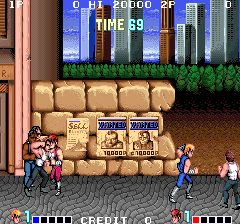
It may not have been the first, but Double Dragon caused the popularity of beat-em-ups to skyrocket almost overnight. It was ported to almost every system available at the time. It spawned a slew of sequels (Double Dragon II: The Revenge, Double Dragon III: The Rosetta Stone/The Sacred Stones, Super Double Dragon, and so on) and imitators - some good, some not. Several of these are covered here.
Available for: NES
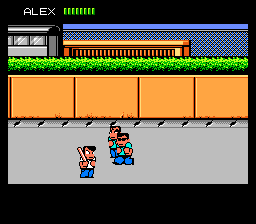
Touted by many as "the best beat-em-up game ever", River City Ransom is truly unique. It combines beat-em-up action with RPG overtones, and in the process creates a game that's unlike any that have come before or since. Originally it was part of the Kunio-kun series in Japan, but since none of the Kunio games that were released in the U.S. showed up under their original titles, it was changed to become RCR, and it became one of the biggest "sleeper" hits Technos ever created for the NES.
Available for: arcade, SNES, Sega CD, GameBoy Advance, PS2, XBox
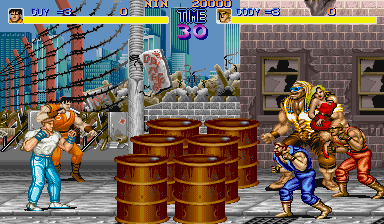
Final Fight was originally intended to be the sequel to Capcom's 1987 arcade hit Street Fighter. During the course of its evolution, however, it ended up being a completely different game than originally intended. It became the start of a brand new series, and was so popular that it spawned several console ports, most notably of which was the SNES version, which was intended to be a system seller. The SNES port was fairly butchered, however - the biggest gaffes Capcom committed was removing Guy and the two player simultaneous option completely from the game. Capcom was besieged by protests from angry gamers, and released another SNES version, Final Fight Guy, which brought back Guy but removed Cody, and still lacked two player simultaneous support. Oh well. Capcom also produced several sequels (Final Fight 2, Final Fight 3 and Final Fight Revenge among them). Capcom has since integrated the characters into the Street Fighter series, and when they decided to do a wrestling game - Saturday Night Slam Masters - Mike Haggar appeared as a playable character (a bit of Mike's past as it were - he was a wrestler before he became mayor of Metro City).
Available for: arcade, SNES
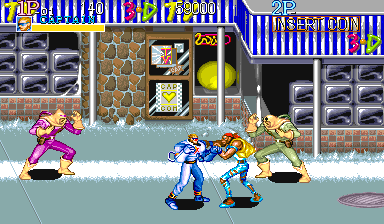
Captain Commando originally appeared in the shmup Section Z. In the early '90s Capcom saw fit to give him his own beat-em-up, and surrounded him with a cast of wacky characters - including a mummy, a mech controlled by a genius baby (!) and a ninja. The game was solid and fun, but got very little notice - especially when the release of Street Fighter II a year later caused just about every beat-em-up to be replaced by one-on-one fighters. The Captain himself survived the transition, however, and ended up as part of Team Capcom in the Marvel Vs. Capcom series.
Available for: arcade
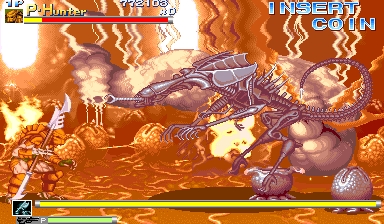
Of all of the licensed beat-em-ups that Capcom produced, Aliens Vs. Predator stands out the most, imo. It was the best use of the license until the first-person shooter AvP games, and easily destroyed Activision's similar SNES title. You were able to take control of either a Predator hunter, a Predator warrior, Lt. Lynn Kurosawa or Major Dutch Schaefer, the character Arnold Schwarzeneggar played in the first Predator film. It wasn't anything new or innovative per se, but it was extraordinarily fun - and admittedly came out at a time that beat-em-ups had been overshadowed by one-on-one fighters (a trend that, ironically, was started by Capcom themselves with the release of Street Fighter II in 1991).
Available for: arcade, Sega Master System, Sega Genesis, Sega Dreamcast
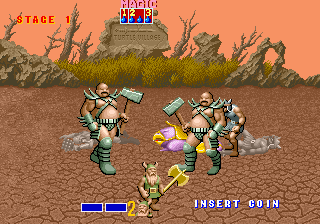
Sega entered the beat-em-up arena with the spectacular Golden Axe. Taking the fighting out of the streets and sending it to a fantasy world populated with all sorts of monsters, demons and skeletons (inspired by the classic film Jason And The Argonauts) did wonders for the genre, as did the other things that were added - each hero (three to choose from! Another first!) wielded a weapon and could unleash magic spells on their enemies. The Sega Genesis port ended up helping sell the Genesis, and the series continued with Golden Axe II and Golden Axe III for the Genesis (Axe III was import only, however), and an arcade sequel - Golden Axe: The Revenge Of Death Adder.
Available for: arcade, Sega Master System*, Sega Genesis
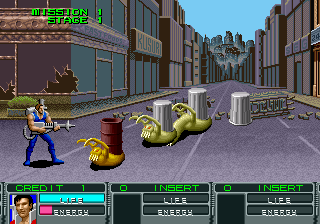
A year after the smash success of Golden Axe, Sega decided to try to strike gold again with Alien Storm. This time, instead of a fantasy setting, Sega opted for a sci-fi setting, even adding side-scrolling and first-person shooter stages to the traditional beat-em-up action. Unfortunately, it didn't quite do the kind of business that Golden Axe did. It was popular enough to be ported to both the SMS and Genesis, though.
Available for: Sega Master System*, Sega Genesis, Sega Game Gear
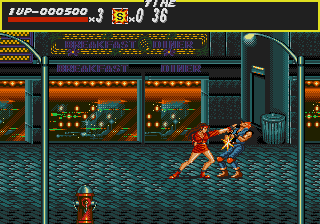
No discussion of beat-em-ups would be complete without mentioning Sega's Streets Of Rage. One of the few titles listed here that was not ported from an arcade game (along with River City Ransom), it was the surprise hit of 1991 for Sega. It went to toe-to-toe with the SNES version of Final Fight - and won (diehard Final Fight fans will dispute that claim, of course). With a huge variety of moves to perform, weapons to use and enemies to kill (not to mention superb music by master maestro Yuzo Koshiro), Streets Of Rage became an instant classic and spawned two sequels - the fantastic Streets Of Rage 2 and the somewhat maligned Streets Of Rage 3 (SoR3's Japanese counterpart, Bare Knuckle 3 fared quite a bit better, as it had been changed drastically to become SoR3).
Available for: arcade
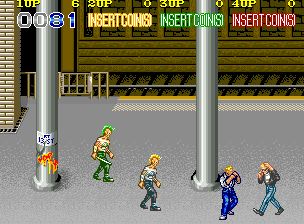
Konami chose to enter the ring with a blatant Double Dragon ripoff, Crime Fighters. That's not to say that the game was bad: in fact, it was the (unless I'm mistaken) first beat-em-up to let four players play simultaneously! It proved to be fairly popular, and ended up being sequelized twice (Vendetta [part 2], and Violent Storm [part 3]) - and with each sequel, the characters grew bigger and more detailed.
Available for: arcade, NES

This game was a monster. Konami scored the license to the Teenage Mutant Ninja Turtles, and (after one sub-par NES sidescroller), came up with an extremely colorful, fun to play masterpiece that was extremely faithful to the original source matierial. The ability for four players to play simultaneously helped boost the game's popularity (each player controlled one of the four turtles), and TMNT stayed on top of the heap for quite some time. Konami ended up porting it to the NES (as TMNT II: The Arcade Game), and then followed it up with an arcade sequel, TMNT II: Turtles In Time. However, by the time Konami decided to port the sequel to a home system, they had already released TMNT III: The Manhattan Project for the NES. The arcade TMNT II eventually hit the SNES as TMNT IV: Turtles In Time. Then Konami released TMNT: The Hyperstone Heist for the Genesis in 1992. After that, Konami switched from beat-em-up to one-on-one fighting in TMNT: Tournament Fighters - but by then, the popularity of the Turtles had declined greatly. What with the recent Turtle revival, Konami is set to bring another TMNT beat-em-up to our screens as of this writing - except this time in 3-D. Konami also used the TMNT game engine in their later arcade beat-em-ups The Simpsons and X-Men.
page 3
